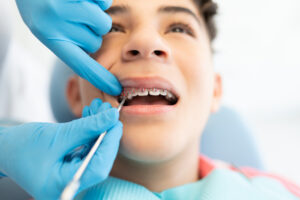Dental Braces Adjustment
A dental braces adjustment involves changing the wires in your orthodontic treatment. These changes pressure your teeth and help them move into their new positions.
During an adjustment appointment, the orthodontist will first remove any colored ties from the brackets and then take the archwire out of your mouth. They will then reattach either your old archwire or a new one to the brackets.

Dental braces are a system of wires and brackets that apply constant pressure to the teeth, gradually moving them into a more correct position. They are most effective in treating orthodontic problems, including underbites, overbites, crooked teeth, and jaw problems. They need to be adjusted regularly to achieve the best results. Regular adjustment appointments also allow your orthodontist to evaluate how your teeth respond to the treatment and make recommendations accordingly.
During an adjustment appointment, your orthodontist will tighten the thin metal archwire between your brackets. They will also adjust or replace the elastic ties that hold the arch wire to your brackets. When these ties stretch or weaken, they cannot create the necessary pressure on your teeth and gums. During an adjustment appointment, it is normal to experience discomfort and sensitivity in your mouth. This can occur due to the added pressure caused by the tightened archwire and new rubber bands.
You should also expect to feel tight after your appointment, progressing to soreness for four to six hours. This soreness directly results from the replacement wires tightening your teeth into place. Over-the-counter pain relievers can help alleviate this discomfort.
To prepare your mouth for the adjustments, your orthodontist will apply a special conditioner to the front surface of each tooth. They will then clean and dry the teeth, removing any existing plaque or food debris. They will then place the brackets on your teeth and apply a special bonding agent to help them adhere. After the brackets are bonded, they will be secured to the archwire using elastic ties.
Eating soft foods that do not require chewing is important if your mouth feels sore after an adjustment appointment. Chewing hard or sticky foods can aggravate the discomfort and could damage your teeth. It is also important to brush and floss regularly. You should also avoid sticky, sugary, or acidic foods, as they can break the bonds between your teeth and the archwires.
The network of metal wires and brackets that make up braces apply pressure to your teeth to align them. This is necessary, but the pressure can also cause discomfort occasionally. The good news is that your orthodontist knows it is happening and can adjust the wires and rubber bands to help keep this pressure on your teeth while reducing the discomfort that can come with it.
The most common type of wire used in orthodontics is nickel-titanium, often abbreviated as Ni-Ti. This thin wire gently pressures the crooked teeth to move them into a straighter position.
Unlike stainless steel wires, which are thick and not as elastic, Ni-Ti wires can be bent to various shapes to apply different amounts of force to your teeth. This is important as it helps your orthodontist get the most out of your treatment.
A broken archwire can be painful, especially if it pokes inside your mouth. You can avoid this by keeping dental wax handy to protect the area. If you find yourself with a broken wire poking into your cheek, you can use a small amount of dental wax or pencil eraser to gently push the wire out of the way and onto a nearby tooth.
When you adjust your braces, the orthodontist will remove the elastic rubber bands holding the archwire in place. Removing these bands will allow the orthodontist to replace them with a new wire with the same amount of pressure on your teeth but without the discomfort of the elastics.
A new archwire will typically have a slightly thicker diameter than the old one, increasing the amount of pressure it exerts on your teeth. This increased pressure will encourage your teeth to continue moving into their final, straight positions. As you can see, adjusting your braces frequently delivers the right pressure level to ensure that your teeth move promptly and produce the desired results.
There are a couple of different kinds of rubber bands used in braces. One is a small elastic band that wraps around the wire and bracket called a ligature. This stays on until the next adjustment, when it is removed and replaced with a new one. The other kind of rubber band is the interarch, which changes throughout the day. They are usually smaller and come in many different colors. Our patients often get creative with their elastics and change them out often for a fun way to decorate their smiles.
Rubber bands put extra pressure on teeth to help them shift and move into alignment. This can cause some discomfort. It is important that patients follow the instructions on wearing them and don’t remove them for meals or to brush or floss. They also need to wear them consistently to shorten the overall treatment time of their orthodontic care.
Please let your orthodontist know if you have any questions or concerns about your comfort level while wearing elastics! They will be able to provide you with some tips and advice to help you be comfortable.
Different kinds of elastics used in orthodontic care include vertical elastics, diagonal elastics, and box elastics. Each of these will have a different purpose and use in helping to adjust a specific part of the bite or the movement of the teeth. Some may feel tighter than others, but it’s important to remember that this slight tightness is good and means the elastic is doing its job.
When applying the elastics, it is important to remember that they need to be stretched in a certain pattern. If the elastic is not placed correctly, it can prevent the desired movement or even make the teeth shift in an unwanted direction. It is also important to avoid double up on elastics as this will put too much pressure on a single tooth or group of teeth and can hurt them.
When braces are tightened, they put pressure on the teeth and gums. The pressure causes an inflammatory response from the body that eventually leads to your teeth moving into their correct positions. While this process is happening, you may feel soreness for a few days. The good news is that each adjustment becomes less painful as time passes.
The orthodontist will inspect your teeth at your appointment to determine what is causing your discomfort. Then, they will tighten the archwire and attach new rubber bands. They will also check to see if the archwire sticks out into your cheek or if any components are loose.
After tightening your braces, you can expect to be sore for several hours. To alleviate the pain, it is recommended that you take an over-the-counter pain reliever. You can also try using an ice pack or sucking on a popsicle to reduce the discomfort.
After your adjustment appointment, you can also eat foods that don’t require much chewing. Mashed potatoes, soups, smoothies, yogurt, and ice cream are great choices that won’t hurt your mouth while you wait for your teeth to adjust to the new braces.
If you find a bracket irritating your tongue or lips, ask the orthodontist to cut it. They can also cut the archwire if it pokes out of your cheek or gums. They will send you home with orthodontic wax that you can use to create a protective barrier over the irritated area. Just be sure only to apply the wax to the bracket causing you pain.
You should also brush your teeth after each meal to remove any food that is stuck in the braces. This will prevent plaque from building up on the teeth and causing tooth decay. It is also recommended that you floss at least once a day to ensure that there are no food particles left behind in the teeth or gums. While it might be uncomfortable, remember that your discomfort is temporary and that your reward will be a straighter smile!
